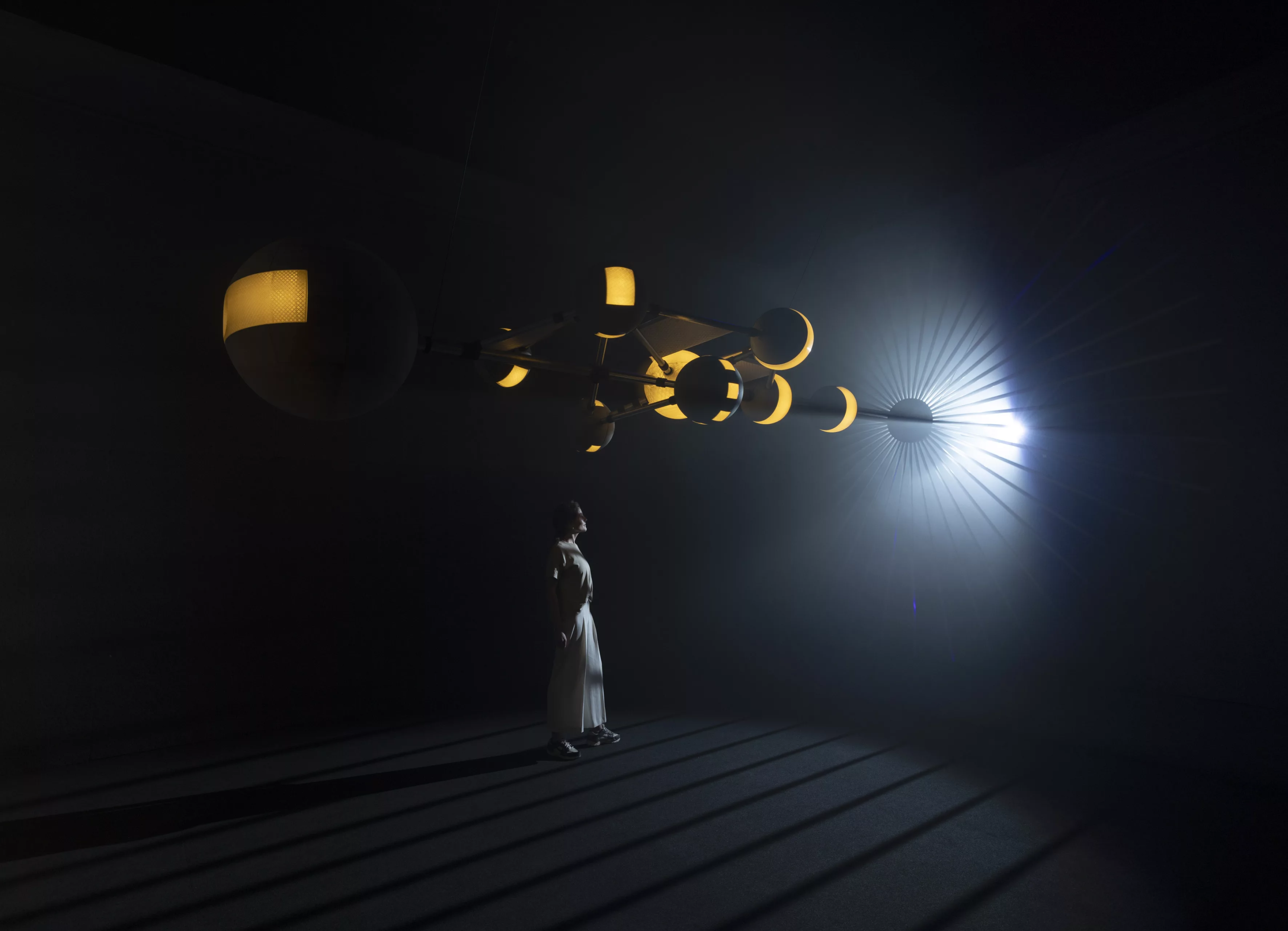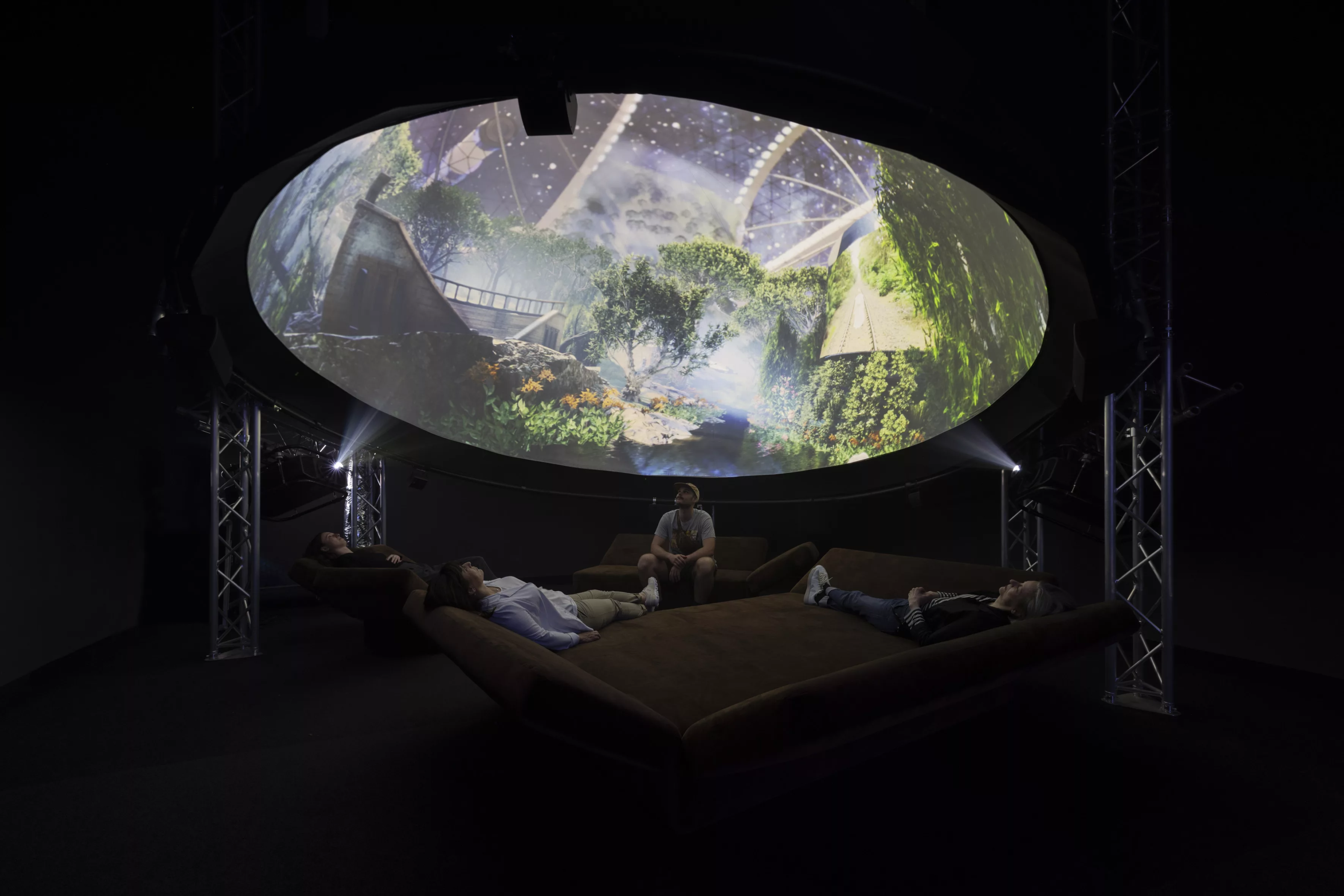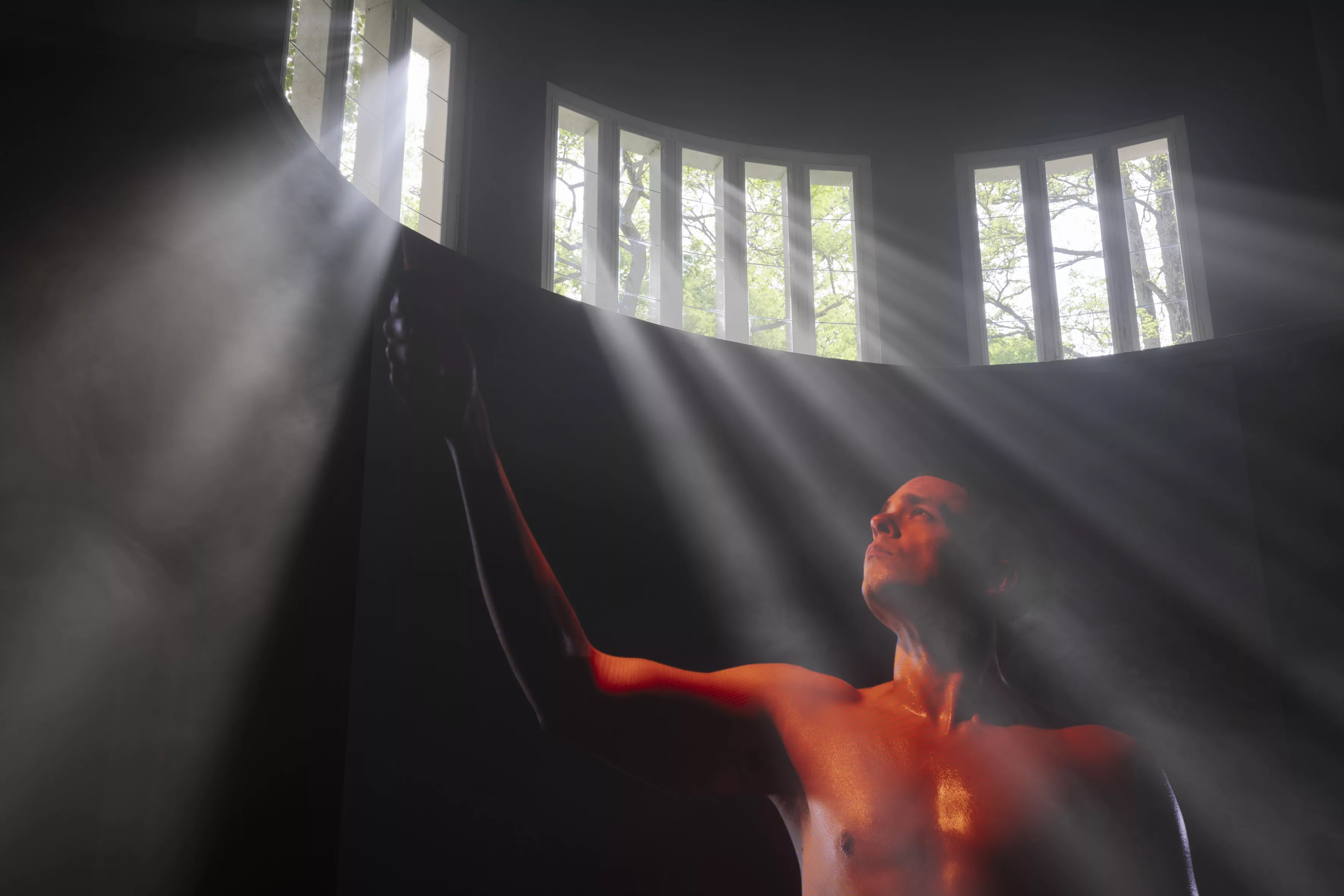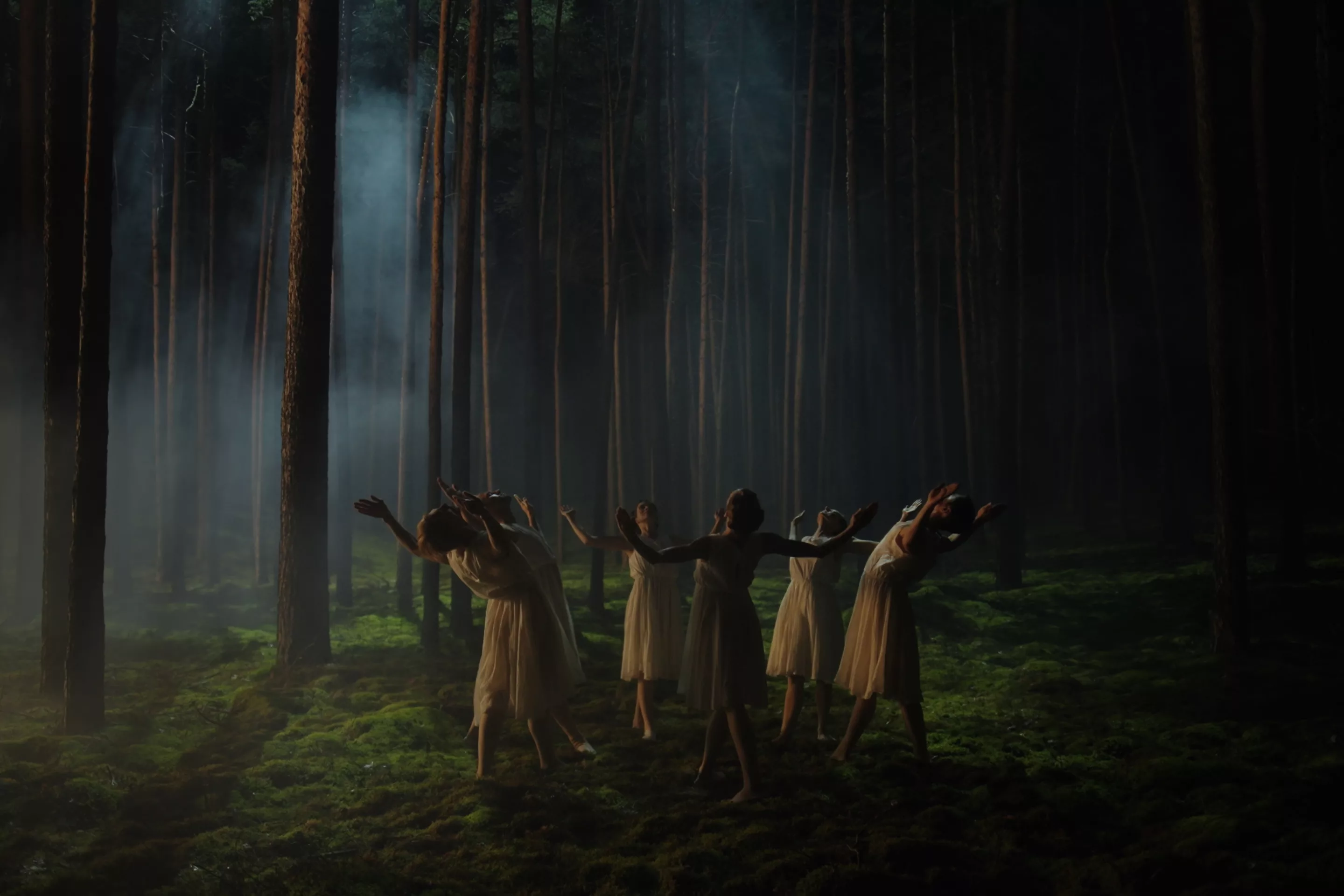To mark her Venice Biennale presentation, Elephant spoke with the Israeli artist about creating “potential futures,” the value that comes from an outsider’s perspective, and why her ambitious project ‘Light to the Nations’ stretches beyond escapism.

Roughly 20 minutes into my hour-long Zoom call with Yael Bartana, one of the artists championed by the German Pavilion at the 60th Venice Biennale, she refers to herself as “an outsider.” For some, this might sound like an empty passing comment. But as I dive deeper into her visionary work – a fluid, surreal and, at times, freaky converging of film, installation, photography, performance and public art – and its connection to her biography, that description becomes more and more pivotal to my understanding of them both.
Born in Kfar Yehezkel, Israel, in 1970, Bartana is now based between Amsterdam and Berlin. When I ask her about her artistic awakening, she recalls approaching art “as a means of investigating concepts of homeland, tradition and nationalism”, particularly in relation to her own country: borrowing from historical narratives, her work reveals how identity is constructed, promoted and passed on from generation to generation. From the very start of her career, Bartana fixed her gaze on the relationship between shared belonging and the manufacturing of consensus, or as she puts it, on “how easy it is for nationhood to spill into totalitarianism”. Her deliberately provocative practice, which appropriates the language of Zionist and Nazi propaganda as a way of “tapping into their difficult histories,” ponders how to resist political and religious extremisms while cultivating pride in local culture.
Her artistic research began to take shape after she decided to leave Israel for Europe in reaction to its ongoing occupation of Palestine: “what brings together all of my characters is that none of them fully belongs,” Bartana says. “They are there but they are also not there –they have different roles, different expectations.” Instead of completely detaching herself from it, she visited the country to grapple with its heritage, peeking into “state, social and self-made rituals, as well as practices of resistance, collective experience and commemoration” through her emigrant perspective. If scrutinising the reality of Israel felt like a natural thing to do for her as an Israeli native, it was only by inserting a physical and mental distance between her and her homeland – “a privileged situation,” the artist recognises – that Bartana was able to “create images that show people what they are unable to see”. Active since the early 2000s, her work has been exhibited internationally, including at the Philadelphia Museum of Art, Amsterdam’s Stedelijk Museum and MoMA PS1 in New York. She has also participated in some of the world’s leading art festivals, from Manifesta and Documenta to the Istanbul, Berlin and São Paulo biennials.
But it was her Venice Biennale debut, which arrived during its 54th edition (2011), to cement Bartana’s influence on the contemporary art world: her film trilogy And Europe Will Be Stunned (2007–2011) speculated a return of Jews to Poland and the establishment of a Jewish state in the region, conjuring questions about memory, colonialism and the unresolved legacy of the holocaust. Its three-part narrative followed the abrupt rise of a fictional political movement advocating for the creation of kibbutz-like settlements in Poland – a clear reference to the early Zionist settlements in Palestine. While on view in Venice, the trilogy, which culminates into the assassination of its political leader, “was such a hit that it was quite difficult to get to see,” wrote The New York Times co-chief art critic Roberta Smith in a 2013 article that looked back at its success. From the Biennale, And Europe Will Be Stunned travelled to four continents, receiving global acclaim while confronting viewers with “Israel’s failed utopia”, as Bartana describes it during our interview.

When I speak to her on a mid-March afternoon, she is “in the middle of intensive production” and zooms in from the sun-filled apartment she has relocated to as one of the recipients of the Rome Prize 2023/24. Established by the German Academy Villa Massimo in 1913, the accolade is one of the most prestigious awards recognising internationally established artists either based in or from Germany. Besides being committed to her Roman fellowship, the artist has recently taken two of her most thought-provoking artworks – What If Women Ruled the World? (2016) and Two Minutes To Midnight (2021) – to Athens’ National Museum of Contemporary Art (EMST). The first one is a neon sign contemplating how different society would be with more female leaders in positions of power. The second, a staged performance of that very scenario: one of Bartana’s most puzzling audiovisual works yet, Two Minutes to Midnight follows an all-women political think tank tasked with the handling of an impending nuclear threat. Both are currently on display at EMST as part of an ongoing cycle of exhibitions dedicated to female-identifying artists rather fittingly named after the former of her pieces.
Elsewhere in Europe, Bartana’s solo show Utopia Now!, another artistic attempt at conceiving viable paths to a positive, unifying future, has just landed at Weserburg Bremen, where it will stay through November 2024. Group presentations of her work have also recently opened at Rome’s Fondazione Memmo, where she showcased a series of stills taken from her deeply allegorical film Malka Germania (2021) – an hallucinatory, mythological video probing “the longing for collective redemption for German and Jewish histories” – and The Book of Malka Germania, a volume derived from the piece; and Kunstverein Dortmund, whose Unselfing exhibition fronted an audiovisual installation delving into Westerners’ cultural appropriation of Indigenous spiritual practices as experienced by her friend and fellow Israeli artist Michael, Pardes (Orchard) (2014). As was the case with her first Venice Biennale appearance, Bartana’s latest Venetian offering has once again impressed the global art community.
Inaugurated in April as part of the German Pavilion Thresholds – an investigation into the notion of the verge, the gradation and the boundary as vessels for spatial, temporal and cultural meaning, curated by Çağla Ilk – her ongoing work Light to the Nations is an imaginative, striking response to the environmental and political threats hindering the future of the planet. Relying on a combination of media including sculpture, VR, video animation and drawing, the project “takes today’s crisis to its extreme, envisioning a life where things have extinguished and it is no longer possible for us to live on Earth,” Bartana says. Unaware of its terrestrial origins, in the artist’s most recent fiction, humanity appears to be based on a generation ship modelled after the ‘tree of life’ diagram of Kabbalah; a line of Judaic mysticism which seeks to restore the interconnectedness of the universe, the divine and the human experience through the teachings symbolised by each one of the ten spherical components of the tree’s outline.

First conceived in 2016, Light to the Nations isn’t the only piece by the artist centred around the aftermath – or the pre-enactment – of an ecological, cultural or societal apocalypse. Set in a colourful rendition of the Pentagon’s War Room providing the backdrop to the political negotiations of Stanley Kubrick’s Dr. Strangelove (1964), “Two Minutes to Midnight, too, deals with the fear of the end of the world” and the sense of uprootedness triggered by it. Meanwhile, her widely cinematic film Inferno (2013) looks at the construction of the Templo de Salmão in São Paulo – a replica of the first temple erected in Jerusalem, whose destruction at the hands of Babylonian troops in 586 BCE heralded the start of the Jewish diaspora – to draw a parallel between the complex sociocultural fabric of Latin America and the history of the Middle East and probe the question: will the building stand the test of time?
Similarly to those older works, Light to the Nations embodies a new, two-part dilemma. “The project comes from an identity crisis which led me to wonder: where are we going to live if ‘here’ is no longer an option? Within that, I wasn’t just trying to understand where our place as Jews could be, but I was also looking at the impact that climate change and ongoing wars are having on people’s lives to come up with [an artistic], optimistic solution [to those issues],” Bartana explains.
Now on view within the Germany Pavilion, a location the artist describes as a “manifestation of Nazi ideology, with its symmetric, imposing architecture and pillars”, Light to the Nations surveys the continuum between utopia and dystopia by countering the building’s infamous legacy through an ethereal representation of the human dimension. Upon stepping into its dimly lit interiors, viewers are presented with a floating model of Bartana’s ‘mothership’ which, emerging from an eye-like, beaming play of lights and shadows, transports the public to a fantastical future. Elsewhere in the pavilion, visitors are invited to discover “life inside the spaceship first-hand,” explains the artist, who has preferred “a VR dome to traditional glasses” for a more organic immersive experience. Within this cocoon of a space, complete with soft seating, her vision of an alternative, extragalactic reality takes shape before our eyes, with lush vegetation and coruscating bodies of water flourishing within the enclosed capsules of her spacecraft. Installed so as to embrace the volumes of the exhibition venue, Bartana’s Farewell (2024) video piece is on display too, as is a film unpacking the conceptualisation of the showcase courtesy of sci-fi expert and art historian Doreet LeVitte-Harten, who served as its artistic advisor.
In the former of these two audiovisual pieces, a group of women dressed in white, semi-transparent soft tunics dance delicately in a circle on the notes of a solemn classical composition, as if in a trance. Joined by an undressed man holding a torch, their movements seem to welcome the arrival of an extraterrestrial vessel, carefully accompanying it as it gets closer to the mossy forest surrounding them. It is a hypnotic sequence that draws you down the rabbit hole – an aesthetic exercise that, especially when considered in relation to the critical outlook Bartana has normally adopted on her country, feels like a blessing and a curse. In Light to the Nations, there appears to be no acknowledgement of the looming ecological, social and political catastrophe referenced by the artist as the main inspiration for the work. Rather than addressing the struggles of a decaying planet and those battling unjust occupation, violence and discrimination, the artist’s compelling cosmos shifts the attention to a clean-cut, almost sanitised depiction of a post-Earth (and arguably post-human) existence. Amid Israel’s severe attacks on Palestine, indulging in fantasies of an otherworldly Arcadia could be seen, at best, as an act of escapism and, at worst, as a dangerous delusion. For Bartana herself, “it is a survival mechanism.”

“The role of art is to stimulate our imagination so we can recognise what we were previously unable to cope with, so we can find answers to questions like, ‘where do we go when the world is broken? What do we want future generations to know about our past? And what is our future?’”, she says. While largely informed by Jewish heritage and traditions – as proves its title, which is taken from a biblical passage – Light to the Nations responds to an urge for redemption that “goes beyond national borders or religious affiliations”. Bartana, who grew up in a secular family, sees her generation ship as “a space of safety, as a vehicle for the hope that is so needed right now,” she says.
“The extent of the destruction in Gaza is something unimaginable and, as an Israeli, it is extremely painful [to watch],” Bartana continues. “Besides Palestine and Ukraine, many other countries going through similar circumstances are barely receiving any media attention. And yet, war is being celebrated in Hollywood: directors are very connected to these issues, they talk about them, explore them in great films and even win Oscars for it. But in reality, [war] just continues. The horrific reality behind it continues. So what is the actual power of art and to whom are we speaking? How can we really change things? All I wish is we could be more effective.”
Words by Gilda Bruno





